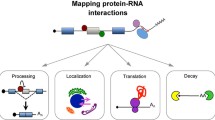Abstract
Bridging the gap between functional genomics and traditional molecular cell biology is a challenge of the next decade. Here, we are aiming to find routines for targeted quantitation of protein silencing in response to RNAi based on complex cellular lysates. A workflow was established adapting siRNA treatment, processing the sample, generating isobaric iTRAQ®-reagent-labeled peptides, and analyzing the sample applying MRM-based peptide quantitation to verify protein silencing on a 4000 QTRAP LC/MS/MS mass spectrometer. Subsequently, eight targets were analyzed, mostly with two siRNA designs. Although transcript and protein silencing correlated, the downregulation on the protein level was less pronounced. A time-course analysis of the chaperon HSPA9/mortalin indicated a delayed kinetic of protein versus transcript silencing. Further, the analysis of the functional response on the example of HSD17B4, a multifunctional enzyme essential to generate precursors for cholesterol biosynthesis, confirmed that strong silencing on the transcript level accompanied by moderate reduction of protein is sufficient to generate a physiological significant response. Fifty percent protein silencing resulted in a 3.5-fold induction of low-density lipoprotein and therefore cholesterol uptake in human liver cells. The established routines pave the way for the development of targeted protein quantitation assays suitable for target and biomarker validation.





Similar content being viewed by others
Abbreviations
- RNAi:
-
RNA interference
- siRNA:
-
Short interfering RNA
- iTRAQ®:
-
Isotope tags for relative and absolute quantification
- MRM:
-
Multiple-reaction monitoring
- MS:
-
Mass spectrometry
- qRT-PCR:
-
Quantitative real-time-PCR
- WB:
-
Western blot
- GAPDH:
-
Glyceraldehyde 3-phosphate dehydrogenase
- miRNA:
-
micro RNA
- LDL:
-
Low-density lipoprotein
References
Echeverri CJ, Perrimon N (2006) Nat Rev Genet 7:373–384
Echeverri CJ, Beachy PA, Baum B, Boutros M, Buchholz F, Chanda SK, Downward J, Ellenberg J, Fraser AG, Hacohen N, Hahn WC, Jackson AL, Kiger A, Linsley PS, Lum L, Ma Y, Mathey-Prevot B, Root DE, Sabatini DM, Taipale J, Perrimon N, Bernards R (2006) Nat Methods 3:777–779
Ryan MC, Zeeberg BR, Caplen NJ, Cleland JA, Kahn AB, Liu H, Weinstein JN (2008) BMC Bioinformatics 9:313
Bonaldi T, Straub T, Cox J, Kumar C, Becker PB, Mann M (2008) Mol Cell 31:762–772
Selbach M, Schwanhausser B, Thierfelder N, Fang Z, Khanin R, Rajewsky N (2008) Nature 455:58–63
Baek D, Villen J, Shin C, Camargo FD, Gygi SP, Bartel DP (2008) Nature 455:64–71
Vinther J, Hedegaard MM, Gardner PP, Andersen JS, Arctander P (2006) Nucleic Acids Res 34:e107
Anderson L, Hunter CL (2006) Mol Cell Proteomics 5:573–588
Wolf-Yadlin A, Hautaniemi S, Lauffenburger DA, White FM (2007) Proc Natl Acad Sci USA 104:5860–5865
Unwin RD, Pierce A, Watson RB, Sternberg DW, Whetton AD (2005) Mol Cell Proteomics 4(7):924–935
Bartlett DW, Davis ME (2006) Nucleic Acids Res 34:322–333
Wadhwa R, Taira K, Kaul SC (2002) Histol Histopathol 17:1173–1177
Yi X, Luk JM, Lee NP, Peng J, Leng X, Guan XY, Lau GK, Beretta L, Fan ST (2008) Mol Cell Proteomics 7:315–325
Petrak J, Ivanek R, Toman O, Cmejla R, Cmejlova J, Vyoral D, Zivny J, Vulpe CD (2008) Proteomics 8:1744–1749
Huyghe S, Mannaerts GP, Baes M, Van Veldhoven PP (2006) Biochim Biophys Acta 1761:973–994
Goldstein JL, Brown MS (1990) Nature 343:425–430
Sachse C, Echeverri CJ (2004) Oncogene 23:8384–8391
Bantscheff M, Schirle M, Sweetman G, Rick J, Kuster B (2007) Anal Bioanal Chem 389:1017–1031
DeSouza LV, Taylor AM, Li W, Minkoff MS, Romaschin AD, Colgan TJ, Siu KW (2008) J Proteome Res 7:3525–3534
Shilov IV, Seymour SL, Patel AA, Loboda A, Tang WH, Keating SP, Hunter CL, Nuwaysir LM, Schaeffer DA (2007) Mol Cell Proteomics 6:1638–1655
Dephoure N, Zhou C, Villen J, Beausoleil SA, Bakalarski CE, Elledge SJ, Gygi SP (2008) Proc Natl Acad Sci USA 105:10762–10767
Acknowledgments
We thank Kathleen Boerner, Sanna Olsson, and Nicole Kiessling for their technical assistance and Andrew Walsh for bioinformatic support. We thank Marjorie S. Minkoff and Michael Hannus for technical advice setting up sample preparation and using the LDL-DiI uptake assay, respectively. Part of this work was supported by grant no. 0313815A and 0313815-C of the BMBF.
Author information
Authors and Affiliations
Corresponding author
Additional information
A. Abdrakhmanova and R. Schlichting contributed equally to this work.
Electronic supplementary material
Below is the link to the electronic supplementary material.
Supplementary Table 1
(PDF 98.5 kb)
Rights and permissions
About this article
Cite this article
Abdrakhmanova, A., Schlichting, R., Hunter, C.L. et al. RNAi and iTRAQ reagents united: targeted quantitation of siRNA-mediated protein silencing in human cells. Anal Bioanal Chem 395, 773–785 (2009). https://doi.org/10.1007/s00216-009-3028-x
Received:
Revised:
Accepted:
Published:
Issue Date:
DOI: https://doi.org/10.1007/s00216-009-3028-x




